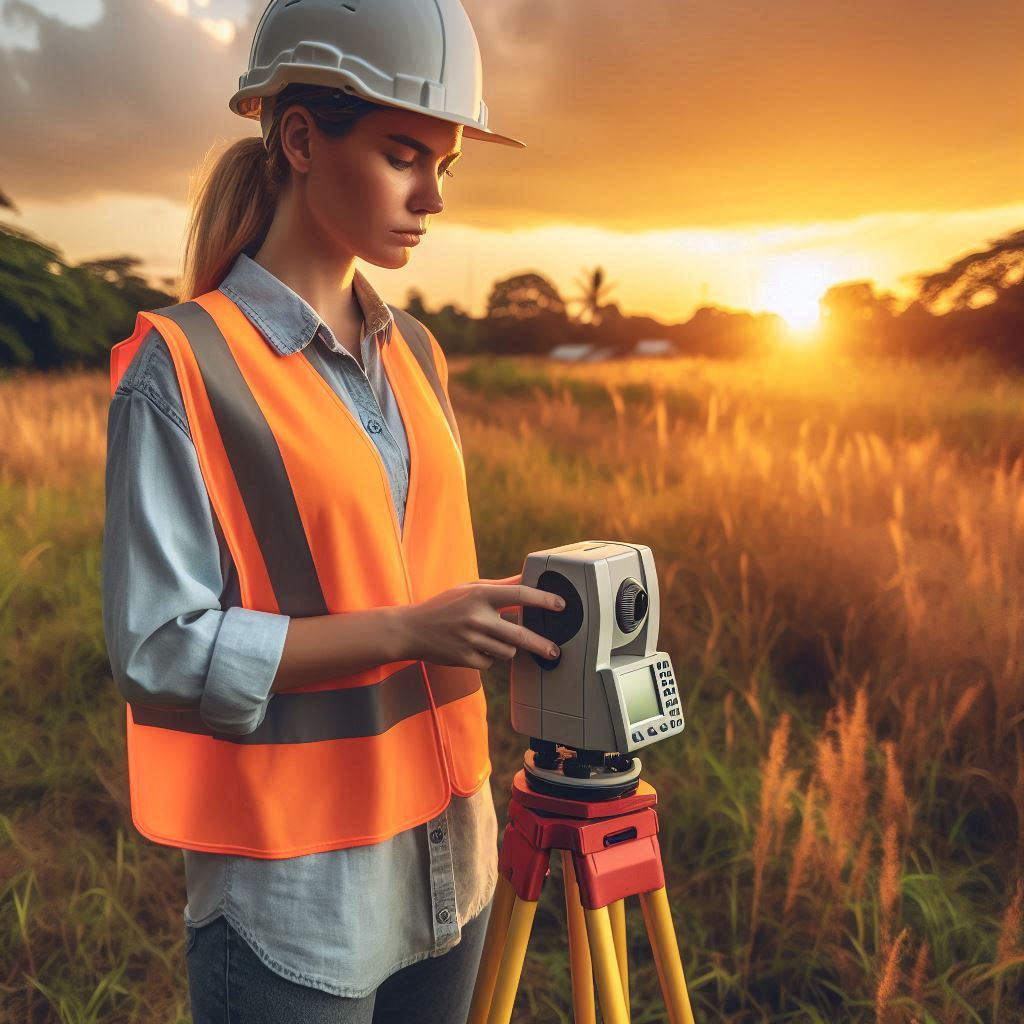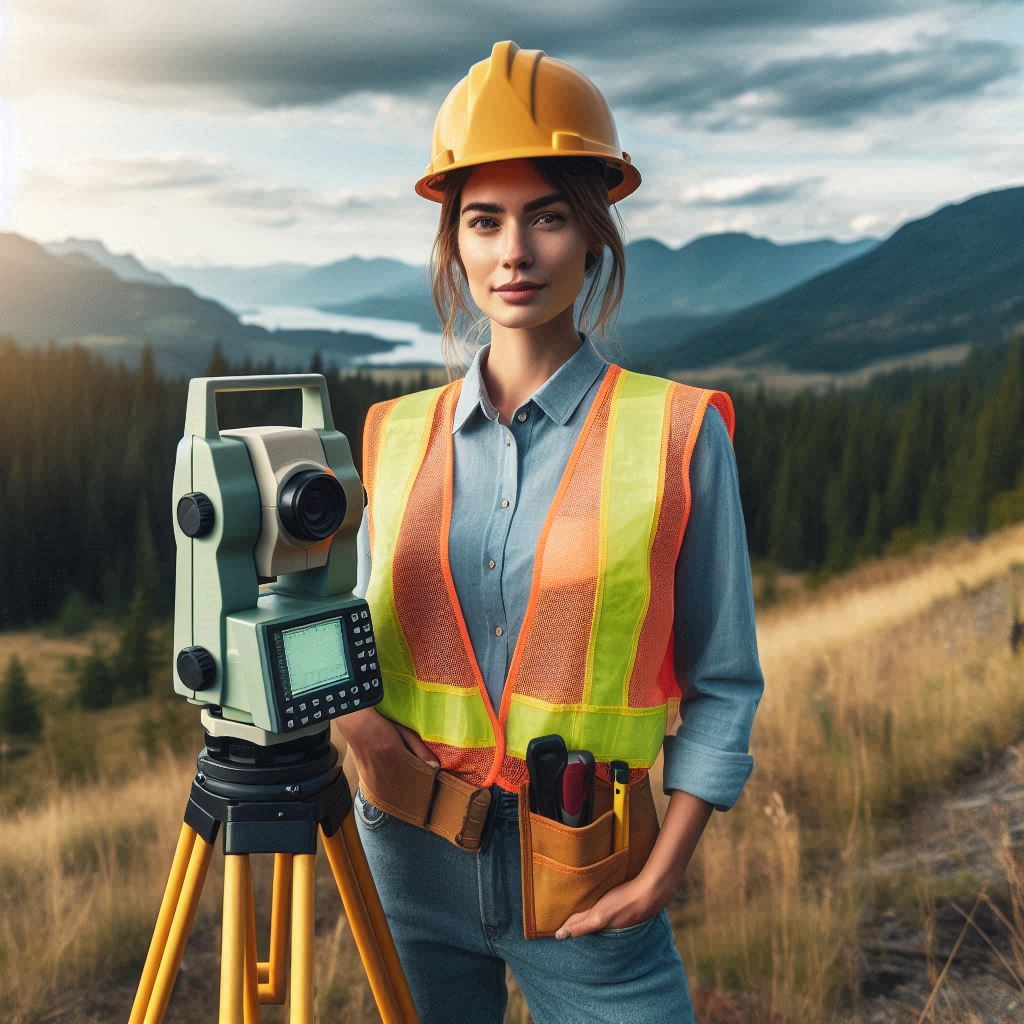Introduction
Surveying and mapping technicians play a vital role in gathering accurate geographic data for Surveying and Mapping Technicians Work Environment.
They use this data for various applications, including construction, land development, and environmental management.
Their work involves measuring and mapping land features with precision instruments and technology.
The work environment of these technicians can vary significantly.
They often work outdoors, facing different weather conditions and terrains.
This fieldwork requires physical stamina and adaptability.
Technicians may need to operate in remote or challenging locations, sometimes in harsh weather or rough terrain.
In addition to outdoor work, technicians also spend time in office settings.
Here, they analyze data, create maps, and prepare reports.
This office work demands attention to detail and proficiency with specialized software and tools.
The importance of a suitable work environment cannot be overstated.
A well-designed workspace and appropriate equipment enhance productivity and accuracy.
Outdoor safety measures are crucial for minimizing risks associated with fieldwork.
Proper gear and safety protocols ensure technicians can perform their duties effectively and safely.
Additionally, a comfortable and organized office space contributes to better data analysis and project management.
It helps technicians stay focused and manage their tasks efficiently.
Duties and Responsibilities of Surveying and Mapping Technicians
Collect Data on the Earth’s Surface
Technicians use advanced technology to collect detailed data on the Earth’s surface.
Tools such as drones, 3D scanners, and GPS systems capture comprehensive geographic information.
Drones provide aerial views that cover large areas quickly, while 3D scanners offer precise measurements of complex structures.
GPS systems ensure accurate location data, which is crucial for creating reliable maps and charts.
Access to these technologies enables technicians to gather extensive and accurate data, which forms the foundation for further analysis and mapping.
Analyze Data to Create Maps and Charts
Once data is collected, technicians analyze it to create detailed maps and charts.
Sophisticated software tools, such as Geographic Information Systems (GIS), facilitate the processing and visualization of data.
These tools allow technicians to integrate various data sources and produce accurate, informative maps.
The analysis involves interpreting geographic features, topographic details, and spatial relationships.
By leveraging advanced software, technicians can generate charts and maps that are both precise and useful for a variety of applications, from urban planning to environmental management.
Conduct Surveys to Establish Boundaries and Property Lines
Technicians also conduct surveys to establish boundaries and property lines.
This process involves measuring and mapping land to determine precise boundaries for legal and developmental purposes.
Surveys are essential for real estate transactions, construction projects, and land disputes.
Technicians use tools like total stations and GPS to perform these surveys accurately.
Collaboration with legal professionals and property owners ensures that the surveyed boundaries are correctly interpreted and documented.
Accurate boundary establishment is crucial for avoiding disputes and ensuring compliance with legal requirements.
Read: Biomedical Engineering: Regulatory Affairs
Types of work environments for surveying and mapping technicians
Surveying and mapping technicians can work in a variety of environments depending on their specific job responsibilities.
Here are the different types of work environments for surveying and mapping technicians:
Outdoor Field Work
Surveying and mapping technicians who work in outdoor field environments spend their days gathering data and measurements directly from the land.
These technicians often work in forests, mountains, deserts, or construction sites to collect information that will be used to create maps and land surveys.
Outdoor field work can be physically demanding and require technicians to work in all types of weather conditions.
Office Work
Some surveying and mapping technicians work primarily in office environments.
In the office, technicians analyze data, create maps, and prepare reports based on the information collected in the field.
Office work may involve using specialized computer software to process and interpret data, as well as collaborating with other professionals such as surveyors and engineers to complete projects.
Office environments are generally more comfortable and climate-controlled compared to outdoor field work.
Remote Locations
Surveying and mapping technicians may also find themselves working in remote locations that are difficult to access.
These technicians travel to remote areas such as mountains, islands, or rural areas to collect data for mapping and surveying projects.
Working in remote locations can be challenging due to limited access to resources and facilities, as well as potential safety concerns.
However, technicians who enjoy adventure and exploration may find remote work to be exciting and rewarding.
Read: Networking Tips for Biomedical Engineers
Challenges in the outdoor field work environment
Exposure to Various Weather Conditions
Surveying and mapping technicians often work outdoors, facing diverse weather conditions.
They must adapt to heat, cold, rain, and wind.
Extreme temperatures can affect their performance and comfort.
During summer, high temperatures can lead to heat exhaustion.
In winter, cold weather poses risks like frostbite.
Rain can make terrain slippery, increasing the risk of falls.
Wind may impact the accuracy of their instruments.
Technicians need to wear appropriate clothing and gear to protect against these elements.
Proper preparation helps them remain effective despite weather challenges.
Physical Demands of the Job
Surveying and mapping technicians engage in physically demanding work.
They frequently walk long distances across varied terrains.
They may need to climb slopes or navigate through dense vegetation.
Carrying heavy equipment is a common part of their duties.
This equipment often includes survey rods, levels, and GPS devices.
The job may require bending, lifting, and kneeling, which can be physically taxing.
Technicians should maintain good physical fitness to handle these demands effectively.
Regular exercise and proper ergonomics are essential to reduce strain and prevent injury.
Safety Hazards
Safety is a critical concern for surveying and mapping technicians.
They encounter various hazards while working outdoors.
Uneven terrain can cause trips and falls, leading to injuries.
Working near roadways exposes them to traffic risks.
Heavy equipment and tools can cause accidents if not used correctly.
Electrical hazards may arise when using equipment near power lines.
Technicians must follow safety protocols to minimize these risks.
Wearing protective gear, such as helmets and safety vests, is essential.
Regular safety training and awareness can help prevent accidents and ensure a safer work environment.
Read: Biomedical Engineer: Working in Healthcare Tech

Advantages of office work for surveying and mapping technicians
Climate-Controlled Environment
Surveying and mapping technicians often work in climate-controlled environments, which offer consistent and comfortable conditions.
These controlled settings help maintain optimal conditions for both the technicians and the equipment they use.
For instance, precision instruments, such as total stations and GPS receivers, perform better in stable temperatures.
The controlled environment reduces the risk of equipment malfunction caused by extreme temperatures or humidity.
Additionally, it enhances the technicians’ focus and productivity, as they are not affected by external weather conditions.
Working in a climate-controlled space ensures that the data collected is accurate and reliable.
Access to Technology and Resources
Technicians in surveying and mapping benefit greatly from access to advanced technology and resources.
Modern tools such as drone technology, 3D scanners, and GIS software are integral to their work.
These tools enable technicians to capture detailed data and perform precise analyses.
Access to high-speed computers and specialized software facilitates the processing and interpretation of complex datasets.
Moreover, ongoing advancements in technology offer new capabilities and improve the efficiency of surveying tasks.
Having access to these resources allows technicians to stay at the forefront of their field and produce high-quality results.
Staying current with technological trends is essential for maintaining a competitive edge in the industry.
Collaboration with Colleagues
Collaboration is a key aspect of the work environment for surveying and mapping technicians.
Technicians often work as part of a team, which includes surveyors, engineers, and project managers.
Effective communication and teamwork are crucial for successful project outcomes.
Collaboration enables the sharing of expertise and knowledge, leading to more accurate and comprehensive data collection.
Read: The Impact of Aerospace Engineering on Modern Life
Uncover the Details: Professional Organizations for Biomedical Technicians
Learn More: Roles and Responsibilities of Environmental Engineers
Transform Your Career Today
Unlock a personalized career strategy that drives real results. Get tailored advice and a roadmap designed just for you.
Start NowRemote locations and their impact on work environment
Isolation and Limited Access to Resources
Surveying and mapping technicians often work in remote or challenging locations.
Isolation from urban centers can limit access to resources and support.
This environment demands high self-reliance.
Technicians must solve problems independently when equipment fails or conditions change unexpectedly.
Limited resources necessitate innovative thinking to overcome obstacles.
Being prepared with spare parts and alternative solutions is crucial.
This self-sufficiency ensures smooth project execution despite remote conditions.
In many cases, technicians operate in isolated areas, like construction sites or undeveloped terrains.
These locations often lack immediate access to advanced tools or facilities.
Thus, a well-equipped toolkit and comprehensive knowledge are essential.
Technicians must adapt quickly to unforeseen challenges, such as equipment malfunctions or environmental changes.
This adaptability is key to maintaining project progress.
Importance of Self-Reliance and Problem-Solving Skills
Self-reliance is a vital trait for surveying and mapping technicians.
Working in isolation requires the ability to troubleshoot issues without external help.
Problem-solving skills become indispensable when facing unexpected challenges.
Technicians often encounter situations where traditional resources are unavailable.
In these scenarios, creativity and resourcefulness are essential.
A proactive mindset allows technicians to devise effective solutions promptly.
Problem-solving skills extend beyond technical issues.
Technicians must also address logistical and environmental challenges.
Effective communication with remote teams and stakeholders becomes crucial in these cases.
Potential for Unique Surveying Opportunities
Isolation and limited access to resources often lead to unique surveying opportunities.
Technicians working in remote locations can uncover new insights and areas of interest.
These environments can present rare geological formations or undiscovered landmarks.
Exploring such areas can significantly impact the field of surveying and mapping.
Additionally, working in isolated locations can lead to advancements in technology and methods.
Technicians often pioneer new techniques to handle unique challenges.
This innovation can drive the development of specialized tools and procedures.
By tackling these challenges, technicians contribute to the broader knowledge base of their field.
You Might Also Like: Top Companies Hiring Solar Photovoltaic Installers
Discover More: Latest Innovations in Agricultural Engineering Technology
Importance of work environment on job satisfaction for surveying and mapping technicians
Impact on Physical and Mental Well-being
Surveying and mapping technicians face a demanding work environment that can impact both physical and mental health.
These professionals often work in diverse locations, from construction sites to remote areas.
Physical health issues can arise from long hours on their feet, exposure to varying weather conditions, and carrying heavy equipment.
Musculoskeletal problems, such as back pain and joint strain, are common due to the physical nature of their job.
Mental well-being also plays a crucial role in their overall health.
The job’s irregular hours and the need to meet tight deadlines can lead to stress and fatigue.
Technicians must stay alert and focused, which can be mentally taxing.
Constant problem-solving and decision-making add to the cognitive load.
Stress management strategies are vital for maintaining mental health.
Regular breaks and effective stress-relief techniques can help mitigate these effects.
Influence on Productivity and Efficiency
The physical and mental well-being of surveying and mapping technicians directly influences their productivity and efficiency.
When technicians experience physical discomfort or mental fatigue, their work performance can decline.
Reduced concentration and slower reaction times can result in errors and rework.
This not only impacts the quality of their work but can also lead to project delays.
Conversely, maintaining good health can enhance productivity.
Technicians who are physically fit and mentally sharp are more likely to complete tasks efficiently.
Regular exercise and a balanced diet contribute to better physical health, while effective stress management and mental health practices improve cognitive function.
An environment that supports technicians’ well-being can lead to increased job satisfaction and higher overall productivity.
Considerations for Work-Life Balance
Achieving a healthy work-life balance is crucial for surveying and mapping technicians.
The nature of their job often requires flexibility in working hours and locations, which can blur the lines between work and personal life.
Technicians must find ways to balance long hours and frequent travel with time spent at home.
Employers can support work-life balance by offering flexible schedules and ensuring reasonable work hours.
Providing access to health and wellness programs can also be beneficial.
Technicians should communicate their needs and establish boundaries to manage work demands effectively.
Time management skills and setting priorities are essential in achieving a harmonious balance.
Conclusion
The work environment is vital for surveying and mapping technicians.
It directly impacts their efficiency and job satisfaction.
Technicians often work in diverse settings, from office spaces to outdoor sites.
Each environment presents unique challenges and opportunities.
A well-organized and safe office space fosters productivity and accuracy.
Modern technology and comfortable workstations enhance focus and performance.
Conversely, a cluttered or poorly equipped office can lead to mistakes and inefficiencies.
Outdoor environments, where technicians conduct fieldwork, require careful attention to safety and comfort.
Harsh weather conditions or challenging terrains can impact their effectiveness.
Proper gear, such as weather-resistant clothing and advanced surveying equipment, is essential.
Ensuring a supportive and well-prepared field environment helps technicians perform their tasks more effectively and safely.
A conducive work environment also influences job satisfaction and overall well-being.
Technicians who work in supportive and well-maintained environments are more likely to remain motivated and engaged.
This leads to higher job retention and better outcomes for projects.
For professionals in the field, prioritizing a positive work environment is crucial.
Invest in maintaining and improving your workspaces, both indoor and outdoor.
Regularly assess and address any factors that may hinder performance.
By doing so, you enhance not only your productivity but also your professional growth.




